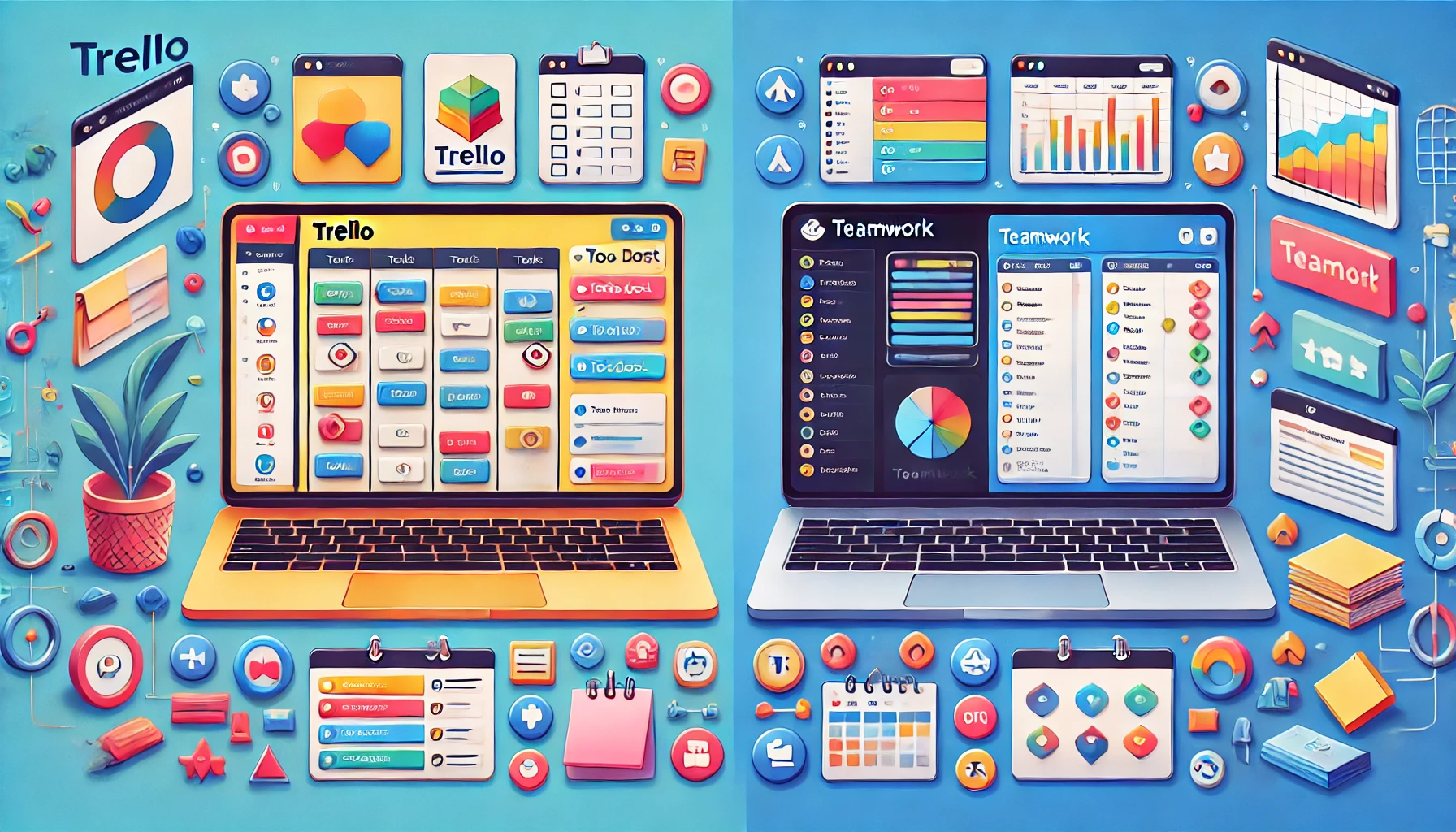When it comes to keeping track of a growing list of tasks, choosing the right tool can make or break your productivity. Both Trello and Teamwork are popular options for task and project management, each with a unique approach to organizing information and helping teams stay on track. But which one is genuinely better for managing your to-dos? Let’s dive into this showdown of Trello vs Teamwork to uncover which platform might be the best fit for your specific needs, whether you’re a solo freelancer, a startup, or an established team with complex project workflows.
Why These Two? A Look at Their Unique Approaches
Trello and Teamwork are both well-established in the project management space, but their styles differ significantly. Trello is highly visual, built around the concept of Kanban boards—think of digital sticky notes arranged in columns. It’s light, intuitive, and visually inviting. You can create custom boards, lists, and cards to break down projects and tasks. For anyone who’s naturally drawn to visual organization or prefers a simple, no-fuss layout, Trello feels like a blank canvas waiting for you to fill it up with ideas and tasks.
Teamwork, on the other hand, is more of a powerhouse in terms of functionality. It was built to handle complex projects with features like Gantt charts, time tracking, milestones, and advanced reporting. While it may look less visually striking than Trello, Teamwork offers a broader suite of tools that appeal to teams needing comprehensive project management capabilities. So, before we even jump into details, it’s worth noting that Trello is typically favored for its simplicity and flexibility, while Teamwork shines when projects are complex and involve multiple steps or resources.
Key Features Showdown
Let’s break down some of the key features in each platform to get a clearer picture of how they handle task and project management. Understanding these core capabilities is essential to figuring out which one aligns with your workflow.
Task Management
Trello: Trello’s task management is built on its iconic Kanban-style boards. Tasks, represented as “cards,” are easily created, organized, and moved between columns (representing stages like “To Do,” “In Progress,” or “Completed”). For individuals or small teams with straightforward workflows, Trello’s visual approach makes it a breeze to see exactly where everything stands.
Teamwork: In Teamwork, task management is more structured and includes advanced options like task dependencies, subtasks, and recurring tasks. This allows for a greater level of detail and control, especially useful when tasks are part of a larger, intricate project. You can track each task’s progress, assign multiple team members, and set priorities, making Teamwork a go-to choice for those who need a deeper level of task organization.
Collaboration and Communication
Trello: Trello makes collaboration easy through real-time updates and card-based communication. You can add team members to specific boards or cards, comment on tasks, and attach files. It’s straightforward, but it lacks some of the robust features of a full communication suite, like chat or file storage beyond attachments. Still, with power-ups (Trello’s version of add-ons) like Slack and Google Drive integrations, Trello can work well if your team is relatively small and doesn’t need extensive communication tools.
Teamwork: Teamwork’s collaboration features are much more extensive, with built-in tools for messaging, team discussions, and file sharing. You can have threaded conversations, which keeps everything organized. Plus, Teamwork’s integration with email means you can communicate with clients and stakeholders without leaving the platform. If you’re working on a project with multiple departments or remote team members, these additional communication features in Teamwork can be a game-changer.
Customization and Flexibility
Trello: One of Trello’s greatest strengths is its flexibility. From changing board backgrounds to setting up custom labels and adding power-ups, you can tailor Trello’s layout and functionality to match your team’s needs. Trello’s simplicity doesn’t limit it here; in fact, it thrives on being adaptable. If you love the idea of a tool that can be as simple or complex as you want it to be, Trello has your back.
Teamwork: Teamwork offers customization but tends to be more structured, giving you preset templates and workflows based on project types. While it’s not as freeform as Trello, this can be a plus for teams that need consistency and detailed reporting. You can modify fields, set custom workflows, and use automation for repetitive tasks, but the emphasis is more on providing a detailed structure rather than flexible visuals.
Usability: Interface and User Experience
Trello: Let’s talk about that unmistakable Trello look. Its visual board interface is a standout feature for anyone who wants a clean, intuitive platform. You can drag and drop tasks between columns, change colors, and add images or checklists to each card. It’s like having a digital corkboard, making it feel familiar even for beginners. But Trello can get cluttered as projects scale—especially if there are multiple teams working on the same board. The simplicity that makes Trello approachable can also make it challenging to scale up for more complex projects.
Teamwork: Teamwork’s interface is more complex but also more robust. It may take some time to get comfortable with the multiple tabs, views, and features available, but once you do, you’ll appreciate its depth. You can switch between board, list, or Gantt chart views, depending on your needs, which offers a lot of flexibility for larger projects. The trade-off is that it’s not quite as intuitive as Trello, so new users might face a learning curve. That said, Teamwork is designed with professional project management in mind, so if you’re managing detailed timelines or resource allocation, the interface ultimately supports that.
Integrations and Power-Ups
Trello: Trello shines in its integrations, known as “power-ups.” These allow you to connect Trello to popular tools like Slack, Google Drive, Jira, and even Teamwork itself if you want to use both tools in tandem. Trello limits the number of power-ups on its free plan, but with a premium plan, you can add as many as you like. This flexibility makes Trello highly customizable and easy to extend, even though it starts out simple.
Teamwork: Teamwork also offers robust integrations, syncing with tools like Google Drive, Dropbox, HubSpot, and Microsoft Office. Additionally, Teamwork has native features that reduce the need for some integrations, such as its built-in time tracking and billing tools. For businesses looking for a solution that combines multiple functions into one, Teamwork’s integrations combined with its own features make it a strong choice.
Pricing and Value for Money
Trello: Trello offers a popular free plan with enough features to manage simple to-do lists or small team projects, though it limits advanced functionality, like power-ups and automation. Upgrading to Trello’s paid plans unlocks features like unlimited power-ups, workspace automation, and higher file storage. For individuals or small teams that don’t need advanced features, the free version is probably enough, while the paid versions offer a balance of additional functionality without a steep price tag.
Teamwork: Teamwork’s pricing is aimed more at businesses needing all-in-one solutions for complex projects. Its free plan is quite limited, but the paid plans offer comprehensive project management tools, time tracking, and client permissions that Trello doesn’t include natively. Though pricier, Teamwork’s plans can be worth it if you’re managing multiple clients or need high-level project tracking capabilities. However, it’s a bigger investment for small teams or individual freelancers.
Advanced Features Comparison
Both Trello and Teamwork bring unique advanced features to the table, and these extras can be what ultimately sway you one way or the other. Let’s explore which standout functions set each tool apart and may tip the scales based on your specific needs.
Time Tracking and Reporting
Trello: While Trello itself doesn’t include built-in time tracking, it offers time-tracking integrations like Toggl and Clockify. For basic task management, this works fine if you don’t need in-depth reporting or billing. But if detailed reports, client billing, or time analysis are crucial for your projects, Trello’s reliance on integrations might feel like a workaround rather than a built-in solution.
Teamwork: Teamwork was built with time tracking in mind, making it a better choice if time management is an essential part of your workflow. With native time-tracking capabilities, you can log hours directly in the platform, track billable hours, and even create invoices based on the time spent on each project. Teamwork’s reporting capabilities also outshine Trello’s, offering custom reports, budget tracking, and detailed project timelines. If you need comprehensive reporting without additional apps, Teamwork is the more powerful choice.
Project Planning and Task Dependencies
Trello: Trello is designed for simple, straightforward task tracking rather than project planning. However, with the help of power-ups like “Card Dependencies” or “Big Picture,” you can add basic dependency features. Trello is great for visualizing tasks in sequence but may fall short if you’re planning a complex project with interdependent tasks. For teams handling larger projects, this limited functionality might be a barrier.
Teamwork: Teamwork stands out in this area, offering built-in dependency management that lets you create relationships between tasks, helping you structure complex workflows more efficiently. You can set up task dependencies, track milestone progress, and view projects in Gantt charts—features that are highly valued in project planning. For anyone working with a more complex workflow, the robust planning tools in Teamwork add substantial value.
Automation
Trello: Trello’s automation feature, known as Butler, is simple yet effective. You can set up rules and commands for tasks like moving cards, setting due dates, or triggering reminders. Butler is user-friendly and works within Trello’s visual structure, making it easy for beginners to add automation to their boards without complex coding. While it’s more limited than some professional automation tools, it’s a strong addition to Trello’s lineup, and for most users, it’s enough to streamline repetitive tasks.
Teamwork: Teamwork’s automation focuses on more advanced project workflows. You can automate specific task assignments, notify teams of upcoming deadlines, and even create custom triggers for different workflows. While not as intuitive as Butler, it provides in-depth customization and can be more effective for those working on multifaceted projects. Teamwork’s automation will benefit you if your needs extend beyond basic task movement or reminders.
Security and Privacy
When handling project data, security and privacy should never be overlooked. Both Trello and Teamwork take measures to ensure that their users’ data is secure, but there are differences worth noting.
Trello: Trello follows standard security protocols, offering data encryption, two-factor authentication, and compliance with GDPR. For most small to medium-sized teams, Trello’s security is adequate. However, Trello does not have native role-based access controls, meaning you’re limited in customizing who sees what within a board. For teams with sensitive data, this may be a consideration.
Teamwork: Teamwork offers enhanced security features with enterprise-grade encryption, compliance with SOC 2 standards, and role-based access control, making it more suitable for businesses that prioritize data security. With Teamwork, you can control access on a granular level, ensuring sensitive information is only available to relevant team members. If privacy and data security are top priorities for your team or clients, Teamwork offers a more robust setup.
Mobile App Functionality
Being able to access your tasks on the go is essential for many users, especially those working remotely or in multiple locations. Trello and Teamwork each have mobile apps, but they differ in their depth and ease of use.
Trello: Trello’s mobile app is widely praised for its simplicity and intuitiveness. Its Kanban board structure works well on mobile screens, allowing you to easily drag and drop cards, add comments, and move tasks around. The app is responsive, making it ideal for anyone who needs quick, on-the-go access without a lot of extra features. However, complex power-ups may not always work seamlessly on mobile.
Teamwork: Teamwork’s app brings its more extensive functionality to mobile, though with a bit of a learning curve due to the feature set. You can access time-tracking, task dependencies, and Gantt charts right from the app. While it may not be as quick and visually straightforward as Trello’s app, it’s highly effective for those who need a fully featured project management solution on mobile. If you’re often away from a desktop and need access to advanced project tools, Teamwork’s mobile app delivers.
Pros and Cons Summed Up
To get a clearer view, let’s break down the pros and cons of Trello and Teamwork:
Trello
Pros:
- User-friendly and visually engaging with Kanban boards
- Flexible for various workflows with numerous power-ups
- Simple, straightforward mobile app
- Great for small teams or solo use
- Affordable and scalable pricing for light users
Cons:
- Limited built-in project management features
- Less suitable for complex project tracking
- Basic reporting and time-tracking options (requires integrations)
- Limited control over access and permissions
Teamwork
Pros:
- Comprehensive task dependencies, Gantt charts, and time tracking
- Advanced reporting and budget tracking
- Strong security features with role-based access control
- Excellent for managing complex projects or client work
- Built-in tools for client communication and collaboration
Cons:
- Higher learning curve, especially for new users
- May feel overly complex for simple task management
- Pricier compared to Trello for small teams or freelancers
- Mobile app can feel dense due to extensive feature set
Which One Should You Choose?
Ultimately, the choice between Trello and Teamwork comes down to your team’s needs, project complexity, and how much detail you want in your task management.
- Choose Trello if you’re looking for a straightforward, visually engaging task management tool that’s easy to use, flexible, and budget-friendly. It’s ideal for small teams or individual users, or those who prefer a simple, no-fuss solution for organizing tasks without a lot of extras.
- Choose Teamwork if you’re managing complex projects that involve multiple departments, need detailed time tracking, or work with clients who require regular updates. Teamwork’s extensive feature set, advanced reporting, and security controls make it a better fit for larger teams or businesses that need an all-in-one solution for project management.
And if you’re feeling stuck? It’s not uncommon for teams to use both tools—Trello for simple task tracking and brainstorming, and Teamwork for the nitty-gritty details of project planning. Both platforms offer integrations that can link them together, letting you take advantage of Trello’s simplicity while accessing Teamwork’s deeper project management features.
Pro Tips
- Trello Power-Ups: Trello’s free version lets you experiment with power-ups, so try adding “Butler” for automation and “Card Dependencies” to create task relationships if you want a touch of structure.
- Teamwork Templates: Take advantage of Teamwork’s templates for project management if you’re managing repetitive workflows; it’s a huge timesaver and keeps projects consistent across your team.
Final Thoughts
Choosing between Trello and Teamwork isn’t an all-or-nothing decision. Both tools are powerful in their own ways, each with a unique approach to handling to-dos and project management. Trello’s visual boards make it ideal for those who think in terms of tasks and stages, while Teamwork’s structured approach and advanced features suit project planners needing comprehensive control.
The best tool for you depends on the depth of your projects and your team’s preferences. If you’re all about visual simplicity and flexibility, Trello’s your go-to. But if you’re diving into large projects and need built-in time tracking, detailed reporting, or task dependencies, Teamwork has the edge. Try them out with free trials, gather your team’s feedback, and find the best fit for a seamless workflow.





